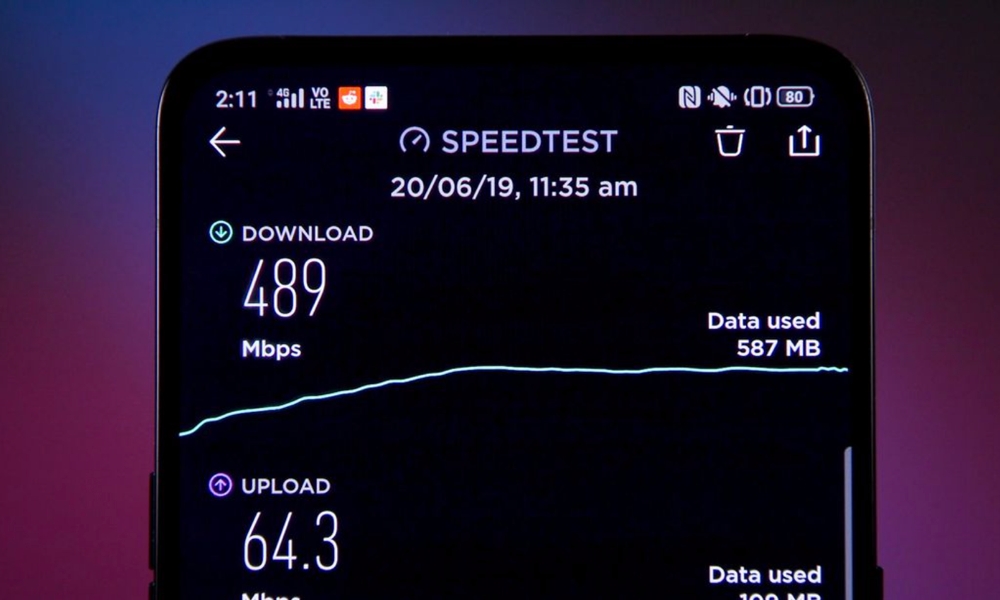Looking Forward to 5G? You’d Better Have an Unlimited Data Plan
 Credit: CNET
Credit: CNET
Toggle Dark Mode
There’s been a lot of excitement about 5G technology coming to the iPhone next year, but despite all of the hype, we’ve been a bit skeptical about how much this is going to matter to the average iPhone user, especially in the short term. Put simply, do you really need your iPhone to be able to transfer data at gigabit speeds?
However, there’s also a dark side to 5G that many users probably haven’t thought about: being able to move data at faster speeds means that you’ll potentially use a lot more of it.
In a new report for CNET, Daniel Van Boom took a closer look at just exactly what the impact of this will be, after conducting a series of tests in the parts of Sydney, Australia where Telstra currently offers solid 5G service.
Van Boom reported that 5G was fast — really fast. On his test device, which was an LG V50 ThinQ, he was able to download a 2.04 GB game in 54 seconds, as compared to the almost six minutes that it would have taken on his office broadband. A 1h 43m movie took 92 seconds. 5G Speed tests showed download speeds pushing close to 500 Mbps, much faster than many smartphones can achieve even over the fastest Wi-Fi connections — for example, even Apple’s 2018 iPhones typically top out at around 400 Mbps over Wi-Fi.
The Problem
The problem, however is that these kinds of speeds will suck through your data plan like a firehose. Van Boom noted that after only 25 minutes, after running several speed tests, including downloading two movies from Netflix and a game, he got a text message telling him that he’d used 50% of his 20 GB data allotment. While 20 GB “isn’t an unusually small amount” in Australia, it’s actually quite high compared to plans that are typically available in North America.
In fact, even so-called “unlimited” plans come with a catch — they won’t charge you for using more data, but you’ll typically find yourself slowed down to speeds below 1 mbps once you exceed the cap, meaning that you’d quickly lose the benefits of 5G in a pretty painful way — it would be like switching from a Bugatti to a bicycle.
While the problem isn’t entirely a new one — some of us can remember how LTE required higher data caps in much the same way, the speeds offered by full 5G coverage are orders of magnitude higher than not only LTE, but than what most typical home broadband networks will provide, so it’s going to be even more tempting to download large videos and games when you’re on the go rather than waiting until you get home, and to make matters worse, there’s a very good chance that most public Wi-Fi hotspots, while free of data caps, aren’t going to offer even a fraction of the performance that 5G will.
Your Mileage May Vary
Not surprisingly, however, 5G is going to have its growing pains, and while Van Boom’s stats showed how fast it will be at optimal speeds, he found quite a bit of variation, and the range of 5G is much more limited than typical LTE networks, so it won’t be hard to find yourself in an area of poor coverage simply by walking a single city block. Still, even the slowest speeds that Van Boom encountered in his travels came in at around 50 Mbps, which beat out typical LTE speeds in Australia, and most real-world LTE performance on U.S. carriers as well.
Although we can hope that the faster speeds offered by 5G may prompt the carriers to offer higher data caps, we’re really not holding our breath, especially in light of the fact that AT&T is already talking about charging more for higher 5G speeds.
With 5G rollouts happening at a similarly slow pace in the U.S., there’s a good chance that coverage is going to be spotty even in major urban areas, and mostly non-existent outside of them — current estimates suggest that only 14 million Americans will have access to 5G at all by the end of 2020. So while by all reports Apple will be offering 5G in at least some of its iPhones next year, it’s unclear how much of a selling feature this will really be for most users.






